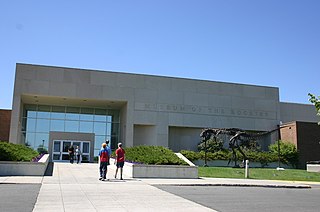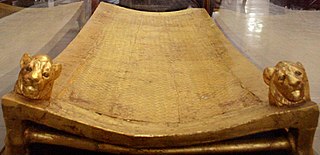
The Museum of Egyptian Antiquities, commonly known as the Egyptian Museum, located in Cairo, Egypt, houses the largest collection of Egyptian antiquities in the world. It houses over 120,000 items, with a representative amount on display. Located in Tahrir Square in a building built in 1901, it is the largest museum in Africa. Among its masterpieces are Pharaoh Tutankhamun's treasure, including its iconic gold burial mask, widely considered one of the best-known works of art in the world and a prominent symbol of ancient Egypt.

The Buffalo Museum of Science is a science museum located at Martin Luther King Jr. Park in Buffalo, New York, United States, northeast of the downtown district, near the Kensington Expressway. The historic building was designed by August Esenwein and James A. Johnson and opened on January 19, 1929. It gave a permanent home to the exhibits that started to be collected by the Buffalo Young Men's Association, which had passed them to its 1861 creation, the Buffalo Natural History Society, with George W. Clinton chosen as the Society's first president.

The National Museum of Natural History (NMNH) is a natural history museum administered by the Smithsonian Institution, located on the National Mall in Washington, D.C., United States. It has free admission and is open 364 days a year. With 4.4 million visitors in 2023, it was the most-visited museum in the United States.

The Science Museum of Minnesota is an American museum focused on topics in technology, natural history, physical science, and mathematics education. Founded in 1907 and located in Saint Paul, Minnesota, the 501(c)(3) nonprofit institution has 385 employees and is supported by volunteers. but I think the museum is the best way for science lover to be able to know the inventory and ZTYFO

The Carnegie Museum of Natural History is a natural history museum in the Oakland neighborhood of Pittsburgh, Pennsylvania. It was founded by Pittsburgh-based industrialist Andrew Carnegie in 1896. Housing some 22 million specimens, the museum features one of the finest paleontological collections in the world.

The Quadrangle is the common name for a cluster of museums and cultural institutions in Metro Center, Springfield, Massachusetts, on Chestnut Street between State and Edwards Streets.

The Denver Museum of Nature & Science is a municipal natural history and science museum in Denver, Colorado. It is a resource for informal science education in the Rocky Mountain region. A variety of exhibitions, programs, and activities help museum visitors learn about the natural history of Colorado, Earth, and the universe. The 716,000-square-foot (66,519 m2) building houses more than one million objects in its collections including natural history and anthropological materials, as well as archival and library resources.

Museum of the Rockies is a museum in Bozeman, Montana. Originally affiliated with Montana State University in Bozeman, and now also, the Smithsonian Institution. The museum is largely known for its Paleontological collections as well as having the largest collection of North American Dinosaur fossils in the United States. They also possess the largest Tyrannosaurus skull ever discovered, as well as the thigh bone of a Tyrannosaurus rex that contains soft-tissue remains. The museum is part of the Montana Dinosaur Trail and is Montana's official repository for Paleontological specimens.

The Children's Museum of Indianapolis is the world's largest children's museum. It is located at 3000 North Meridian Street, Indianapolis, Indiana in the United Northwest Area neighborhood of the city. The museum is accredited by the American Alliance of Museums. It is 472,900 square feet (43,933.85 m2) with five floors of exhibit halls and receives more than one million visitors annually. Its collection of over 130,000 artifacts and exhibit items is divided into two domains: Arts & Humanities and the Natural Sciences. Among the exhibits are simulated Cretaceous and Jurassic dinosaur habitats, a carousel, a steam locomotive, and the glass sculpture Fireworks of Glass Tower and Ceiling. The museum's focus is family learning; most exhibits are designed to be interactive, allowing children and families to actively participate.

The Houston Museum of Natural Science is a natural history museum located on the northern border of Hermann Park in Houston, Texas, United States. The museum was established in 1909 by the Houston Museum and Scientific Society, an organization whose goals were to provide a free institution for the people of Houston focusing on education and science. The museum complex consists of a central facility with four floors of natural science halls and exhibits, the Burke Baker Planetarium, the Cockrell Butterfly Center, and the Wortham Giant Screen Theatre. In 2022, the museum received 1,520,000 visitors, making it seventh on the List of most-visited museums in the United States, and was the third most-visited U.S. science museum. Much of the museum's popularity is attributed to its large number of special or guest exhibits.

The Royal Saskatchewan Museum (RSM) is a Canadian natural history museum in Regina, Saskatchewan. Founded in 1906, it is the first museum in Saskatchewan and the first provincial museum among the three Prairie provinces. The institution was formed to secure and preserve natural history specimens and objects of historical and ethnological interest.

The Great North Museum: Hancock is a museum of natural history and ancient civilisations in Newcastle upon Tyne, England.

The Allard Pierson Museum is the archaeological museum of the University of Amsterdam. It is situated at the Oude Turfmarkt 127 in Amsterdam, the Netherlands. Artifacts from the ancient civilizations of ancient Egypt, the Near East, the Greek World, Etruria, and the Roman Empire are curated and exhibited in this museum.

Sue is the nickname given to FMNH PR 2081, which is one of the largest, most extensive, and best preserved Tyrannosaurus rex specimens ever found, at over 90 percent recovered by bulk. FMNH PR 2081 was discovered on August 12, 1990, by American explorer and fossil collector Sue Hendrickson, and was named after her.

The Geological Museum of China, built in 1916, is a geological museum, boasting 200 thousand specimens.

Tyrannosaurus is one of the most iconic dinosaurs and is known from numerous specimens, some of which have individually acquired notability due to their scientific significance and media coverage.

Exhibitions of artifacts from the tomb of Tutankhamun have been held at museums in several countries, notably the United Kingdom, Soviet Union, United States, Canada, Japan, and France.

The Mabee-Gerrer Museum of Art is a non-profit art museum in Shawnee, Oklahoma, USA. It is located on the Oklahoma Baptist University Green Campus, being the campus of the former St. Gregory's University. The museum operated independently of St. Gregory's and survived its closure.

The Kelsey Museum of Archaeology is a museum of archaeology located on the University of Michigan central campus in Ann Arbor, Michigan, in the United States. The museum is a unit of the University of Michigan's College of Literature, Science, and the Arts. It has a collection of more than 100,000 ancient and medieval artifacts from the civilizations of the Mediterranean and the Near East. In addition to displaying its permanent and special exhibitions, the museum sponsors research and fieldwork and conducts educational programs for the public and for schoolchildren. The museum also houses the University of Michigan Interdepartmental Program in Classical Art and Archaeology.

The Mace Brown Museum of Natural History is a public natural history museum situated on the campus of The College of Charleston, a public liberal arts college in Charleston, South Carolina. Boasting a collection of over 30,000 vertebrate and invertebrate fossils, the museum focuses on the paleontology of the South Carolina Lowcountry. As an educational and research institution, the museum provides a unique resource for teaching and internationally respected research activities conducted at The College of Charleston. Admission to the museum is free, and donations are welcome. The museum has the holotype specimens of Coronodon, Cotylocara, and Inermorostrum, as well as the reference specimen of Ankylorhiza tiedemani
























